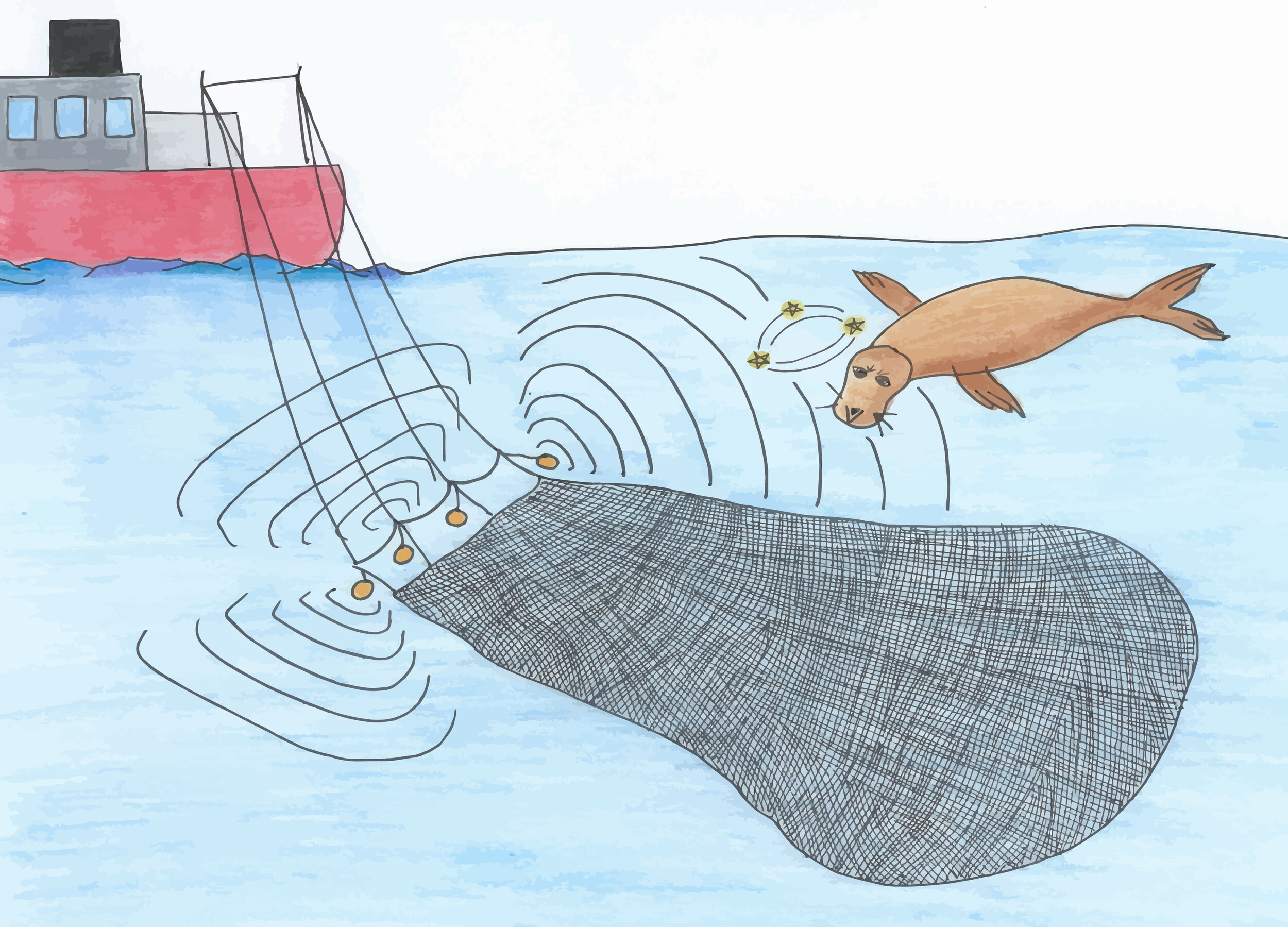Noise
The ocean has many natural sources of noise and the general ambient acoustic environment in the ocean varies widely. This variation is dependent on a combination of factors: geographical location, time and environmental conditions. Contributors to natural ocean noise include:
1) Wind, sea state and swell
2) Currents and turbulence
3) Seismic activity
4) Precipitation
5) Marine life
Noise pollution is the significant and increasing anthropogenic (human) contribution to ocean noise and is found to be having concerning impacts on marine life. Marine mammals in particular are suffering highly. Mass stranding events causing mass mortality are occurring frequently and are attributed to invasive underwater noise pollution.
Where does it come from?
Anthropogenic noises within the marine environment are becoming more pervasive and powerful, this results in an increase in both ocean background noise and intensity levels. Anthropogenic noise pollution sources are grouped into general categories:
Large commercial ships
Air guns (used for oil exploration)
Military, Naval and ship sonars
Acoustic deterrent devices and pingers
Drilling rigs
Commercial shipping is a major contributor of low frequency noise pollution in the world’s oceans. These large ships contribute to background noise over huge geographical areas.
Multiple airguns are usually used during oil exploration, to image the earth’s crust: a technique that is used to identify reserves of oil and natural gas under the seafloor:
Sonar acoustics are used to explore surroundings and identify objects within the water column. Military sonar is used as a method to locate ships and submarines.
Acoustic deterrent devices and pingers, placed on nets are used to create local acoustic annoyance to repel marine mammals from fishing boats and fish farms. These efforts are implemented to reduce bycatch in nets and prevent predation by the mammals.
The industrial construction and work efforts on coastline shallow waters as well as open ocean sites are generating significant noise. Coastal power plants in addition to oil and gas activities are among numerous sources of construction related noise pollution. Recent developments has instigated the move of oil and gas production from shallow water settings to water depths of up to 3000m. Associated problems with deep ocean productions is the creation of far greater noise pollution at depth than at shallow water productions.
How is it harmful?
General effects:
There are many varying ecological effects of noise pollution on marine life within the ocean. The introduction of powerfully persistent anthropogenic noise is causing disruption to the communication of many marine animals. This is a process known as masking. Many animals use sound during mating and reproduction as well as foraging, predation and predator evasion. The addition of noise pollution masks an individuals ability to successfully communicate or sense important acoustic cues that may help them determine their location and navigate.
The overall ecological implications of noise pollution on marine organisms occur anatomically, physically and behaviourally. Noise pollution causes physical changes that cause growth abnormalities, negative immune system responses and changes to reproductive organs. This has consequential impacts to the success of a population as well as its community structure. Noise pollution results in anatomical variations including hearing loss, sensory organ damage and buoyancy control problems. This has been found to cause disorientation, strandings and mortality, again this has a consequence to population success and structure. Behavioural impacts can be some of the most serious. Noise pollution is documented to result in an inability to communicate, to detect prey or evade predators through sensory cues. It also changes foraging behaviour, orientation and diving behaviour. This is one of the most significant causes of disorientation, stranding and mortality in marine mammals as well as affecting predator prey interactions and feeding success.
Low frequency commercial ship noise has been attributed to chronic stress and this has been explicitly seen in the Northern Right Whale. Recent technological evolution, scientific understanding and research developments is reporting the increasing susceptibility of a greater diversity of marine species to detrimental impacts of noise pollution. This is documented as hearing loss and significant behavioural changes.
Mass strandings:
One of the most publicised ecological effects of noise pollution is mass marine mammal strandings attributed to naval or military sonar. In 2002, 14 beaked whales in the Canary Islands were stranded due to naval sonar use in the area. The first publicised stranding event that resulted from US Navy sonar exercises was in the Bahamas in 2000. Within hours of the exercises, 18 marine mammals of various species including beaked whales were stranded in multiple locations across Bahamas Islands. In this particular circumstance, beaked whales were notable because they were not known to have mass stranded previously in the area.
Sonar produces high intensity acoustic energy that is believed to disrupt the natural diving behaviours of marine mammals. In beaked whales species such as the Cuvier’s beaked whale, their diving depths reach up to 3000m. Sonar disruption to the mammals diving at these depths cause rapid ascent and surfacing and results in the movement of air bubbles into tissues. Super saturation of tissues with nitrogen gas and additional lesions have been found during post mortems on stranded animals and have been found to be consistent with decompression sickness resulting in multi organ haemorrhaging.
Species Affected
The species most commonly affected by sonar noise pollution, and who suffer highly fatal consequences are:
The Common Minke whale
The Cuvier’s Beaked whale
The Pilot whale
The Blainville’s Beaked whale
The Pygmy Sperm whale
The Dwarf Sperm whale
The Short Beaked dolphin
The Striped dolphin
The Harbour porpoise
What has been done?
The current measures to combat marine noise pollution are generally ineffective. This is deemed to be a result of measures focusing on limiting ecological damage to animals within a close range of the noise source and excluding any consequences of noise pollution penetrating longer distances as a chronic underlying problem.
Increasing recognition of the effects of noise pollution has instigated substantial investment into improving scientific knowledge. $25 million per year has been provided by a combination of the US Navy and the US oil and gas industry to fund noise pollution research. Similarly European research funding is also increasing and £3 million has already been provided for collaborative research efforts.
Hopefully this positive movement might help instigate funding for further and more diverse research into marine noise pollution. Currently commercial and recreational shipping remains unregulated. There have been suggestions and voluntary guidelines proposed by the International Maritime Organisation for quieting underwater radiated noise from commercial ships, yet none have been lawfully implemented.
A notable exception to the inability to reduce anthropogenic noise seems to be when silence in the sea is of crucial concern: military stealth. Developments to military vessels, especially submarines has achieved noise reduction and prevention of unnecessary vibrations. It therefore seems that if it is beneficial to us to reduce noise in our oceans, then the scientific technological developments are possible and the expenditure justified.
The current problem faced is persuading people that the health of marine life is an important enough reason to invest and develop noise reducing technologies for our loud anthropogenic ocean activities.
















